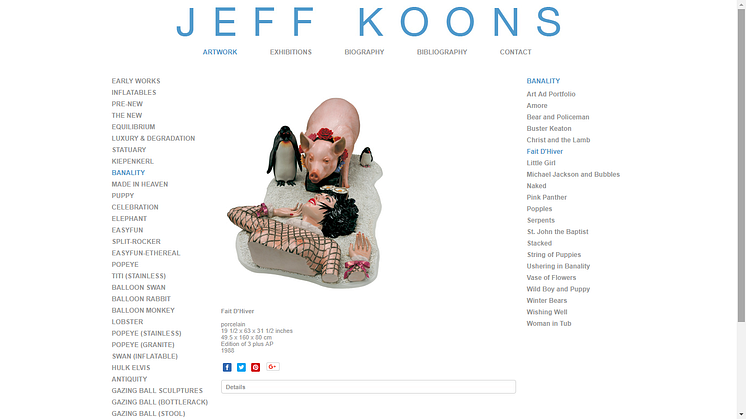
News -
Jeff Koons, serial plagiarist, gets caught again
American artist Jeff Koons has lost a legal claim alleging copyright infringement, this time in a French court for plagiarising an advertising campaign in the 1980s.
The artist and the Center Pompidou in Paris will have to pay a fine of 148,000 euros for copyright infringement to Franck Davidovici, who created an advert for clothing retailer Naf-Naf broadcast in the 80s.
“Fait d’hiver” is a 1988 statue by Jeff Koons featuring a woman lying in snow being nuzzled by a pig. “Fait d’hiver” is also a 1985 advertisement for the French clothing brand Naf Naf featuring a woman lying in snow being nuzzled by a pig.
There are a number of differences between the two works, starting with the fact that Koons’ “Fait d’hiver” is a sculpture and not a black-and-white photograph. Koons’ woman also has sunglasses on her forehead, while his pig is wreathed in flowers. But the pig is wearing a cask on its neck, which is the same as the Naf Naf ad. The women in the two works bear a similar expression. And the staging is similar to Davidovici’s work.
This is not the first time Koons has found himself in trouble due to his derivative works. His 1988 exhibition “Banality,” based on images from advertising and magazines, gave rise to five lawsuits, some decades after the original exhibit.
The cases produced by the “Banality” shows resulted in judgements that have helped to define when artists can and cannot use the work of others for their own pieces, making a lasting impact on copyright law.
The most high profile one is the lawsuit by photographer Art Rogers, who claimed Koons copied his work by creating a sculpture, “String Of Puppies”, based on his photograph of a couple holding eight German shepherd puppies.
Koons did not deny copying the postcard. But his defence in court was that he had transformed Rogers’ two-dimensional image to a three-dimensional sculpture. Also, his intention was to parody the original image and so it qualified as fair use, a legal defense to copyright infringement.
Koons and his lawyer argued that the artist believed “the mass production of commodities and media images has caused a deterioration in the quality of society, and this artistic tradition of which he is a member proposes through incorporating these images into works of art to comment critically on both the incorporated object and the political and economic system that created it.”
But if Koons’ argument is to be believed, parody, defined as the humorous form of social commentary and literary criticism in which one work imitates another, could be used as a blanket exemption for copying any work from another artist.
The court accordingly disagreed with the artist’s line of argument, pointing to the fact that the copied work must be, at least in part, “an object of the parody, otherwise there would be no need to conjure up the original work.” The court noted that if the point was to parody society broadly, Koons did not need to use copy Rogers’s work specifically.
The Rogers judgment meant that a parody defence would require the parody of the appropriated artwork. Parody would not be allowed as a blanket rationalisation for an entire genre of art that commented on broad cultural and societal concepts.
The court said: “In short, it is not really the parody flag that appellants (Koons and Sonnabend Gallery, his principal gallery) are sailing under, but rather the flag of piracy. Moreover, because we have already determined that "String of Puppies" is not a parody of Rogers' work, appellants cannot avail themselves of this heightened tolerance under a parody defense.”
In an interview with The New York Times after the judgment in 1992, Koons asked: "Since when did judges qualify as art critics?"
